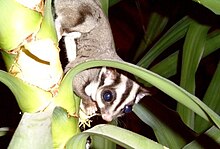
Back بتروس Arabic بتروس ARZ Ekibol (Petaurus) AVK پتاوروس AZB Petaurus Breton Petaure Catalan Petaurus CEB Gleithörnchenbeutler German Petaurus Spanish بادپرکیسهدارها Persian
| Petaurus | |
|---|---|

| |
| Sugar glider | |
| Scientific classification | |
| Domain: | Eukaryota |
| Kingdom: | Animalia |
| Phylum: | Chordata |
| Class: | Mammalia |
| Infraclass: | Marsupialia |
| Order: | Diprotodontia |
| Family: | Petauridae |
| Genus: | Petaurus Shaw, 1791 |
| Type species | |
| Petaurus australis Shaw, 1791
| |
| Species | |
The genus Petaurus (/pə.tɔːˈrəs/) contains flying phalangers or wrist-winged gliders, a group of arboreal possums native to Australia, New Guinea, and surrounding islands. There are eight species: the sugar glider, savanna glider, Krefft's glider, squirrel glider, mahogany glider, northern glider, yellow-bellied glider and Biak glider.[1]
Flying phalangers are typically nocturnal, most being small (sometimes around 400 mm (16 in), counting the tail), and have folds of loose skin (patagia) running from the wrists to the ankles. They use the patagia to glide from tree to tree by jumping and holding out their limbs spread-eagle. They are able to glide for distances over 140 metres (460 ft). Beside the distinctive skin folds, flying phalangers also have large, forward-facing eyes, short (though pointed) faces, and long flat tails which are used as rudders while gliding.
All are omnivores, and eat tree sap, gum, nectar, pollen, and insects, along with manna and honeydew. Most flying phalangers appear to be solitary, though the yellow-bellied glider and sugar glider are both known to live in groups.
- ^ "Petaurus". ASM Mammal Diversity Database. American Society of Mammalogists. Retrieved 2021-06-19.